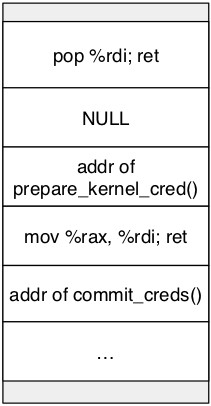Change Self¶
Warning
The current page still doesn't have a translation for this language.
You can read it through Google Translate.
Besides, you can also help to translate it: Contributing.
内核会通过进程的 task_struct 结构体中的 cred 指针来索引 cred 结构体,然后根据 cred 的内容来判断一个进程拥有的权限,如果 cred 结构体成员中的 uid-fsgid 都为 0,那一般就会认为进程具有 root 权限。
struct cred {
atomic_t usage;
#ifdef CONFIG_DEBUG_CREDENTIALS
atomic_t subscribers; /* number of processes subscribed */
void *put_addr;
unsigned magic;
#define CRED_MAGIC 0x43736564
#define CRED_MAGIC_DEAD 0x44656144
#endif
kuid_t uid; /* real UID of the task */
kgid_t gid; /* real GID of the task */
kuid_t suid; /* saved UID of the task */
kgid_t sgid; /* saved GID of the task */
kuid_t euid; /* effective UID of the task */
kgid_t egid; /* effective GID of the task */
kuid_t fsuid; /* UID for VFS ops */
kgid_t fsgid; /* GID for VFS ops */
...
}
因此,思路就比较直观了,我们可以通过以下方式来提权
- 直接修改 cred 结构体的内容
- 修改 task_struct 结构体中的 cred 指针指向一个满足要求的 cred
无论是哪一种方法,一般都分为两步:定位,修改。这就好比把大象放到冰箱里一样。
直接改 cred¶
定位具体位置¶
我们可以首先获取到 cred 的具体地址,然后修改 cred。
定位¶
定位 cred 的具体地址有很多种方法,这里根据是否直接定位分为以下两种
直接定位¶
cred 结构体的最前面记录了各种 id 信息,对于一个普通的进程而言,uid-fsgid 都是执行进程的用户的身份。因此我们可以通过扫描内存来定位 cred。
struct cred {
atomic_t usage;
#ifdef CONFIG_DEBUG_CREDENTIALS
atomic_t subscribers; /* number of processes subscribed */
void *put_addr;
unsigned magic;
#define CRED_MAGIC 0x43736564
#define CRED_MAGIC_DEAD 0x44656144
#endif
kuid_t uid; /* real UID of the task */
kgid_t gid; /* real GID of the task */
kuid_t suid; /* saved UID of the task */
kgid_t sgid; /* saved GID of the task */
kuid_t euid; /* effective UID of the task */
kgid_t egid; /* effective GID of the task */
kuid_t fsuid; /* UID for VFS ops */
kgid_t fsgid; /* GID for VFS ops */
...
}
在实际定位的过程中,我们可能会发现很多满足要求的 cred,这主要是因为 cred 结构体可能会被拷贝、释放。一个很直观的想法是在定位的过程中,利用 usage 不为 0 来筛除掉一些 cred,但仍然会发现一些 usage 为 0 的 cred。这是因为 cred 从 usage 为 0, 到释放有一定的时间。此外,cred 是使用 rcu 延迟释放的。
间接定位¶
task_struct¶
进程的 task_struct 结构体中会存放指向 cred 的指针,因此我们可以
-
定位当前进程
task_struct结构体的地址 -
根据 cred 指针相对于 task_struct 结构体的偏移计算得出
cred指针存储的地址 -
获取
cred具体的地址
comm¶
comm 用来标记可执行文件的名字,位于进程的 task_struct 结构体中。我们可以发现 comm 其实在 cred 的正下方,所以我们也可以先定位 comm ,然后定位 cred 的地址。
/* Process credentials: */
/* Tracer's credentials at attach: */
const struct cred __rcu *ptracer_cred;
/* Objective and real subjective task credentials (COW): */
const struct cred __rcu *real_cred;
/* Effective (overridable) subjective task credentials (COW): */
const struct cred __rcu *cred;
#ifdef CONFIG_KEYS
/* Cached requested key. */
struct key *cached_requested_key;
#endif
/*
* executable name, excluding path.
*
* - normally initialized setup_new_exec()
* - access it with [gs]et_task_comm()
* - lock it with task_lock()
*/
char comm[TASK_COMM_LEN];
然而,在进程名字并不特殊的情况下,内核中可能会有多个同样的字符串,这会影响搜索的正确性与效率。因此,我们可以使用 prctl 设置进程的 comm 为一个特殊的字符串,然后再开始定位 comm。
修改¶
在这种方法下,我们可以直接将 cred 中的 uid-fsgid 都修改为 0。当然修改的方式有很多种,比如说
- 在我们具有任意地址读写后,可以直接修改 cred。
- 在我们可以 ROP 执行代码后,可以利用 ROP gadget 修改 cred。
间接定位¶
虽然我们确实想要修改 cred 的内容,但是不一定非得知道 cred 的具体位置,我们只需要能够修改 cred 即可。
(已过时)UAF 使用同样堆块¶
如果我们在进程初始化时能控制 cred 结构体的位置,并且我们可以在初始化后修改该部分的内容,那么我们就可以很容易地达到提权的目的。这里给出一个典型的例子
- 申请一块与 cred 结构体大小一样的堆块
- 释放该堆块
- fork 出新进程,恰好使用刚刚释放的堆块
- 此时,修改 cred 结构体特定内存,从而提权
但是此种方法在较新版本内核中已不再可行,我们已无法直接分配到 cred_jar 中的 object,这是因为 cred_jar 在创建时设置了 SLAB_ACCOUNT 标记,在 CONFIG_MEMCG_KMEM=y 时(默认开启)cred_jar 不会再与相同大小的 kmalloc-192 进行合并
void __init cred_init(void)
{
/* allocate a slab in which we can store credentials */
cred_jar = kmem_cache_create("cred_jar", sizeof(struct cred), 0,
SLAB_HWCACHE_ALIGN|SLAB_PANIC|SLAB_ACCOUNT, NULL);
}
修改 cred 指针¶
定位具体位置¶
在这种方式下,我们需要知道 cred 指针的具体地址。
定位¶
直接定位¶
显然,cred 指针并没有什么非常特殊的地方,所以很难通过直接定位的方式定位到 cred 指针。
间接定位¶
task_struct¶
进程的 task_struct 结构体中会存放指向 cred 的指针,因此我们可以
-
定位当前进程
task_struct结构体的地址 -
根据 cred 指针相对于 task_struct 结构体的偏移计算得出
cred指针存储的地址
common¶
comm 用来标记可执行文件的名字,位于进程的 task_struct 结构体中。我们可以发现 comm 其实在 cred 指针的正下方,所以我们也可以先定位 comm ,然后定位 cred 指针的地址。
/* Process credentials: */
/* Tracer's credentials at attach: */
const struct cred __rcu *ptracer_cred;
/* Objective and real subjective task credentials (COW): */
const struct cred __rcu *real_cred;
/* Effective (overridable) subjective task credentials (COW): */
const struct cred __rcu *cred;
#ifdef CONFIG_KEYS
/* Cached requested key. */
struct key *cached_requested_key;
#endif
/*
* executable name, excluding path.
*
* - normally initialized setup_new_exec()
* - access it with [gs]et_task_comm()
* - lock it with task_lock()
*/
char comm[TASK_COMM_LEN];
然而,在进程名字并不特殊的情况下,内核中可能会有多个同样的字符串,这会影响搜索的正确性与效率。因此,我们可以使用 prctl 设置进程的 comm 为一个特殊的字符串,然后再开始定位 comm。
修改¶
在具体修改时,我们可以使用如下的两种方式
- 修改 cred 指针为内核镜像中已有的 init_cred 的地址。这种方法适合于我们能够直接修改 cred 指针以及知道 init_cred 地址的情况。
- 伪造一个 cred,然后修改 cred 指针指向该地址即可。这种方式比较麻烦,一般并不使用。
间接定位¶
commit_creds(&init_cred)¶
commit_creds() 函数被用以将一个新的 cred 设为当前进程 task_struct 的 real_cred 与 cred 字段,因此若是我们能够劫持内核执行流调用该函数并传入一个具有 root 权限的 cred,则能直接完成对当前进程的提权工作:
int commit_creds(struct cred *new)
{
struct task_struct *task = current;//内核宏,用以从 percpu 段获取当前进程的 PCB
const struct cred *old = task->real_cred;
//...
rcu_assign_pointer(task->real_cred, new);
rcu_assign_pointer(task->cred, new);
在内核初始化过程当中会以 root 权限启动 init 进程,其 cred 结构体为静态定义的 init_cred,由此不难想到的是我们可以通过 commit_creds(&init_cred) 来完成提权的工作
/*
* The initial credentials for the initial task
*/
struct cred init_cred = {
.usage = ATOMIC_INIT(4),
#ifdef CONFIG_DEBUG_CREDENTIALS
.subscribers = ATOMIC_INIT(2),
.magic = CRED_MAGIC,
#endif
.uid = GLOBAL_ROOT_UID,
.gid = GLOBAL_ROOT_GID,
.suid = GLOBAL_ROOT_UID,
.sgid = GLOBAL_ROOT_GID,
.euid = GLOBAL_ROOT_UID,
.egid = GLOBAL_ROOT_GID,
.fsuid = GLOBAL_ROOT_UID,
.fsgid = GLOBAL_ROOT_GID,
.securebits = SECUREBITS_DEFAULT,
.cap_inheritable = CAP_EMPTY_SET,
.cap_permitted = CAP_FULL_SET,
.cap_effective = CAP_FULL_SET,
.cap_bset = CAP_FULL_SET,
.user = INIT_USER,
.user_ns = &init_user_ns,
.group_info = &init_groups,
.ucounts = &init_ucounts,
};
(已过时) commit_creds(prepare_kernel_cred(0))¶
在内核当中提供了 prepare_kernel_cred() 函数用以拷贝指定进程的 cred 结构体,当我们传入的参数为 NULL 时,该函数会拷贝 init_cred 并返回一个有着 root 权限的 cred:
struct cred *prepare_kernel_cred(struct task_struct *daemon)
{
const struct cred *old;
struct cred *new;
new = kmem_cache_alloc(cred_jar, GFP_KERNEL);
if (!new)
return NULL;
kdebug("prepare_kernel_cred() alloc %p", new);
if (daemon)
old = get_task_cred(daemon);
else
old = get_cred(&init_cred);
我们不难想到的是若是我们可以在内核空间中调用 commit_creds(prepare_kernel_cred(NULL)),则也能直接完成提权的工作

不过自从内核版本 6.2 起,prepare_kernel_cred(NULL) 将不再拷贝 init_cred,而是将其视为一个运行时错误并返回 NULL,这使得这种提权方法无法再应用于 6.2 及更高版本的内核:
struct cred *prepare_kernel_cred(struct task_struct *daemon)
{
const struct cred *old;
struct cred *new;
if (WARN_ON_ONCE(!daemon))
return NULL;
new = kmem_cache_alloc(cred_jar, GFP_KERNEL);
if (!new)
return NULL;